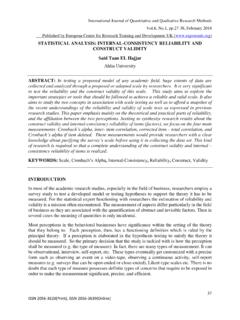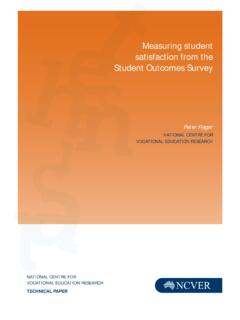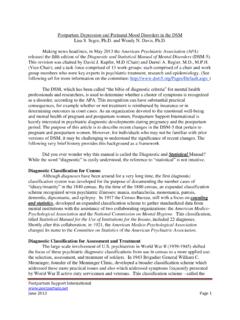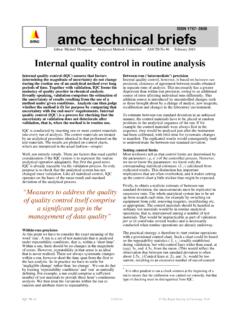Transcription of CRONBACH’S ALPHA 1
1 CRONBACH S ALPHA 1 Understanding a Widely Misunderstood Statistic: Cronbach s Nicola L. Ritter Texas A&M University _____ Paper presented at the annual meeting of the Southwest Educational Research Association, New Orleans, February 18, 2010 CRONBACH S ALPHA 2 Abstract It is important to explore score reliability in virtually all studies, because tests are not reliable. The present paper explains the most frequently used reliability estimate, coefficient ALPHA , so that the coefficient's conceptual underpinnings will be understood. Researchers need to understand score reliability because of the possible impact reliability has on the interpretation of research results.
2 There are several common misconceptions about the basic ideas of score reliability. Misconceptions are formed due to lack of understanding of the concept of reliability and through careless speech involving statistical jargon. This paper addresses common misconceptions so that later discussions over score reliability will not be hindered. Misconceptions have caused some authors to devalue the reporting of reliability estimates in published research, while others report reliability coefficients inappropriately. A better understanding of score reliability can resolve these misconceptions and enable authors to use reliability coefficients appropriately in literature and speech. A background of the basic ideas of score reliability is introduced and concludes with an explanation of the most frequently used reliability estimate, coefficient ALPHA , so that the coefficient's conceptual underpinnings will be understood.
3 CRONBACH S ALPHA 3 Understanding a Widely Misunderstood Statistic: Cronbach s Researchers often want to evaluate the importance of a study s results by using at least one of the types of significance: statistical significance, practical significance, and clinical significance. As practical significance gains support in publications, researchers will begin to notice the influence that reliability has on effect sizes and statistical power against Type II error. Researchers need to understand score reliability because of the possible impact reliability has on the interpretation of research results. Thompson (1994) warns, The failure to consider score reliability in substantive research may exact a toll on the interpretations within research studies.
4 For example, we may conduct studies that could not possibly yield noteworthy effect sizes given that score reliability inherently attenuates effects sizes. Or we may not accurately interpret the effect sizes in our studies if we do not consider the reliability of the scores we are actually analyzing. (p. 840) There are several common misconceptions about the basic ideas of score reliability. Misconceptions are formed due to lack of understanding of the concept of reliability and through careless speech involving statistical jargon. One should address these misconceptions to prevent misinterpretations of research results. A common misconception is that reliability is a characteristic of a test or a measurement tool; however, reliability instead is a characteristic of scores. Spearman (1904) introduced this characteristic by utilizing a method that measures each individual multiple times.
5 In this method, Spearman determined reliability based on the consistency of the individual s scores across equivalent measurement forms. If consistency is CRONBACH S ALPHA 4 seen across measurement forms, then one can conclude that the scores are reliable. If there is no consistency across measurement forms, then one can conclude the scores are not reliable. The method in which Spearman (1904) applied shows that individual scores were tested, not the measurement tool. As Henson (2001) suggested, Because scores may vary in degree of reliability, a given test may yield grossly divergent reliability estimates on different administrations (p. 178). Another common misconception is that reliability is equivalent to validity.
6 Validity pertains to the extent to which scores measure the intended concept. Reliability determines if the scores measure anything, while validity determines to what extent the scores measure the intended something. The relationship between validity and reliability is analogous to the relationship between effect size andcalculat edp. For example, if a person repeatedly measured the same two grams of seasoning for a given recipe, consistently producing the same estimate of the seasoning s weight, this may support that the scores are reliable. However, if one implies from the scores, This recipe tastes great because two grams of seasoning can make anything taste good, then questions of score validity may surface from the individual s dinner guests. Scores must be reliable to even consider if the scores are valid, but reliability does not necessarily imply validity.
7 If scores were not reliable, then one would merely be consistently measuring nothing. Reliability is not equivalent to validity because reliability and validity are two separate properties of scores. These misconceptions are demonstrated through the verbiage in journal articles (Thompson, 1992) and careless jargon used in informal speech (Thompson, 2003). Thompson (2003) exposed these misconceptions to researchers in the hope that through enlightenment researchers will better evaluate scores. Misconceptions have caused some authors to devalue the reporting of reliability estimates CRONBACH S ALPHA 5 in published research (Vacha-Haase, Henson & Caruso, 2002) while others report reliability coefficients inappropriately (Thompson, 1992, 2003; Wilkinson & APA Task Force on Statistical Inference, 1999).
8 A better understanding of score reliability can resolve these misconceptions and enable authors to use reliability coefficients appropriately in literature and speech. An explanation of the basic idea of score reliability and a focus on the properties of one of the most commonly reported reliability estimate, Cronbach s (1951) ALPHA ( ), will be discussed further. Background of Reliability consistency of Scores Reliability pertains to the consistency of scores. The less consistency within a given measurement, the less useful the data may be in analysis. For example, a recipe calls for two grams of a seasoning. The package of seasoning states the contents of the package includes two grams of seasoning. To begin cooking, one measures two grams of seasoning that does not seem to use the entire package. Curiosity sets in and the person decides to measure the seasoning again.
9 To the person s surprise, the second measure indicates a score more than two grams of seasoning. Stubbornly, the person measures the seasoning a third time and notices a score less than two grams of seasoning. Baffled at these results, one may begin to question all of the scores produced by the measuring tool. The person concludes the measurement tool does not measure anything. When measurement tools generate random scores, the scores are not reliable. On the other hand, suppose the person measured the seasoning multiple times and generated two grams each time; this set of scores would then be considered reliable. Types of Reliability There are several coefficients to estimate the reliability of scores, such as internal consistency , test-retest, and form equivalence coefficients. Each type of coefficient estimates CRONBACH S ALPHA 6 consistency across different parameters.
10 internal consistency coefficients estimate the degree in which scores measure the same concept. To put this in context of the cooking example, the individual is testing the weight of the seasoning instead of the chemical composition or pH of the seasoning. Test-retest coefficients estimate stability of scores over a period of time. Form equivalence coefficients estimate consistency of scores between two test forms. internal consistency coefficients are convenient to calculate because such coefficients require only a single measurement given at one time. internal consistency coefficients are more practical than other reliability coefficients due to the lack of time and resources to perform the multiple tests seen in test-retest coefficients and the multiple formats seen in form equivalence coefficients. There is no preference for a single method.
















